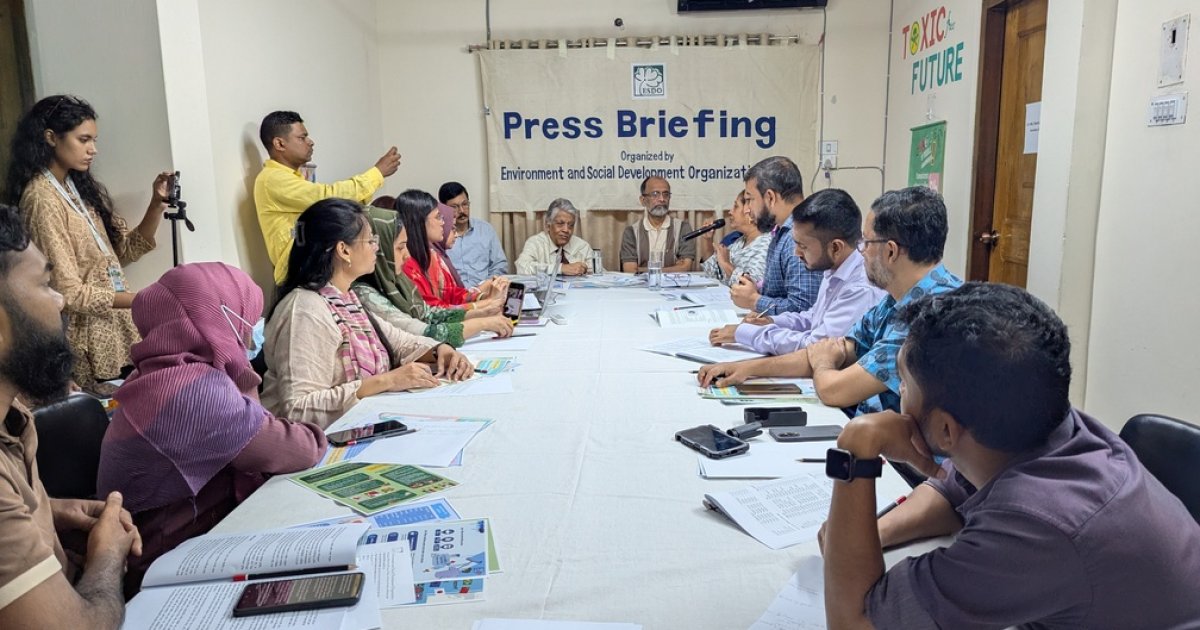According to Bangladeshi law, the maximum permissible limit of lead in paints is 90 parts per million (ppm). However, a recent study on decorative paints sold in the market—including local, industrial, and spray paints—found that nearly 42% of paints contained dangerously high levels of lead, reaching up to 1,90,000 ppm.
The research, titled “Assessment of Lead Presence in Paints and Progress Towards a Lead-Free Bangladesh,” was conducted by the Environment and Social Development Organization (ESDO), in collaboration with the Lead Exposure Elimination Project (LEEP), Instiglio, BSTI, and Unicef. The findings were presented at ESDO’s office in Lalmatia, Dhaka, on Tuesday.
Lead is a heavy metal naturally found in the earth’s crust. Due to its ease of melting and resistance to corrosion, it has been widely used in various products for centuries. Lead is highly toxic, and no level of exposure is considered safe. It can severely affect health, especially in children, causing damage to the nervous system, slowed growth and development, learning and behavioral problems (including reduced IQ, hyperactivity, hearing and speech issues, and anemia), as well as impairing brain, kidney, and nervous system function. For pregnant women, lead exposure increases the risk of miscarriage, premature birth, and low birth weight. In adults, it can elevate blood pressure, increase heart disease risk, damage kidneys, impair reproductive health, and reduce memory and attention.
For the study, samples were collected from 37 paint shops in Dhaka and 161 shops in Chittagong between July and August 2025. The study included 73 different brands of local and imported paints, covering household, industrial, and spray paints. Samples were sent to the internationally accredited Wisconsin Occupational Health Laboratory in the United States for analysis.
Out of 161 tested samples, 93 (57.8%) were within the safe limit (under 90 ppm), mainly from leading national and multinational brands such as Berger, Asian Paints, and Nippon. However, 68 samples (42.2%) exceeded the BSTI safety limit. Among them, 26.2% contained more than 1,000 ppm, and 3.1% contained over 50,000 ppm of lead. These high-lead brands were mostly small, local, or unregistered manufacturers, lacking proper laboratory testing or regulatory oversight.
The study identified the 10 brands with the highest lead concentrations. Kangaroo brand topped the list, recording 1,90,000 ppm of lead, followed by Euro (170,000 ppm). The Kangaroo sample was imported and not produced in Bangladesh. Other high-lead samples included Nahar (81,000 ppm), New Tua (74,000 ppm), Top Seal (54,000 ppm), Madina Better Rubilac (19,000 ppm), Meghna Plus (18,000 ppm), Rami (18,000 ppm), and Turki (16,000 ppm).
These paints were primarily yellow or golden-yellow oil/solvent-based decorative paints. Yellow paints had the highest lead concentrations, with red and white also showing elevated levels. Some paints intended for industrial use were sold as decorative paints. Only 21.6% of paints (35 out of 162) carried a “lead-free” or “environment-friendly” label.
More than half of the surveyed shopkeepers were unaware of BSTI’s lead limits. Samples with over 10,000 ppm of lead came exclusively from small or informal manufacturers. Inconsistencies were also found in imported paints from China, Singapore, and other sources.
Despite mandatory lead regulations introduced in 2018, irregularities and inconsistencies persist in the market. Leading multinational brands like Berger, Asian Paints, and Nippon were the most compliant with safety standards. In contrast, small and medium local brands, including Kangaroo, Nahar, and Meghna Plus, violated safety limits.
ESDO Chairman and former secretary Syed Margub Morshed emphasized: “We urge authorities and industry stakeholders to take immediate action to eliminate lead from all paints to protect public health. We advocate for shared responsibility across production, marketing, and use.”
Former additional secretary Mahbub Kabir Millan said: “Our goal should be complete lead elimination. Policies must be reviewed, and strategies developed to remove lead chromate powder from the market.”
BSTI Director (Chemical Wing) Khodeza Khatun noted procedural challenges in addressing non-compliant brands but assured efforts to resolve them. BSTI Assistant Director (Chemical Standards Wing) Md Manjurul Karim added: “Many manufacturers deliberately evade regulations. We need effective measures to bring them under control and also establish rules for industrial paints.”
Berger Paints representative Masud Rana said: “Lead may be cheaper in production, but it poses significant health risks. We recommend using safe organic pigments that do not harm human health.”



